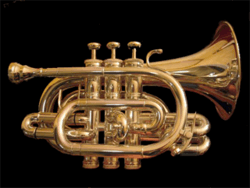Pocket trumpet

The pocket trumpet is a compact size B♭ trumpet, with the same playing range as the regular trumpet. The length of the tubing, if straightened, would measure the same as that of a standard trumpet. However, the tubing is wound more tightly than that of a standard trumpet to reduce the instrument's size while retaining the characteristic sound. The bell is generally of smaller diameter than a standard trumpet. It is not a standardized instrument to be found in concert band or orchestra brass sections and is generally regarded as a novelty. It is used mostly by trumpet players as a practice instrument that can be packed in a suitcase and taken to places where carrying standard trumpets would be a problem. Although not having a reputation as a serious concert band or orchestra instrument, it has occasionally been used by soloists in jazz (e.g., Don Cherry) or other ensembles to add flair and variety.
History, design, and properties
The concept of reducing the brass instrument size without reducing the resonating tube length can be seen in several 19th century models of cornet. Pocket cornets have been constructed since the 1870s and are used in marching bands.[1]
The variation in design among pocket trumpets makes tonal characteristics and playability extremely variable from model to model. Yet there are two basic design approaches to pocket trumpets:
- reduced bell and bore size design
- standard bell and bore size design.
The models with reduced bell and bore size design originate in 19th century pocket cornet design and regularly suffer from poor intonation and severely hindered dynamic and timbral range. As the bell is not the standard size, no standard mute can be applied. The models with standard bell and bore size design originally appeared in the USA in as late as 1968, mostly following the design of trumpet builder Louis Duda (one-piece hand-hammered "5X" bell, cornet-wound lead pipe, straight-back first valve slide with thumb-throw, fold-back third slide), and manufactured by the Benge Trumpet company.[2] It has been claimed to be "the 'gold standard' by which other professional pocket trumpets are measured".[3]
Although most often used for practicing purposes, pocket trumpets are sometimes played as auxiliary instruments by soloists in jazz and dixieland bands, as well as for some specific studio recording demands. Don Cherry's work with the Ornette Coleman quartet is probably the best known example of pocket trumpet playing.
"Dirty" Walter A. Kibby II of the band Fishbone uses a pocket trumpet for all live shows and recordings.
Onetime Elevator/French Toast drummer and former Fugazi roadie Jerry Busher plays a pocket trumpet on The Evens' song, "Competing With The Till", which is on The Evens' "The Odds" album.
New Orleans artist Shamarr Allen plays a Kanstul pocket trumpet with a raised bell in most performances.[4]
Prices range from about US$120 to US$5000; a professional grade instrument would bear a similar price tag to a standard instrument in the same category.
Standard features
- Bell Diameter: 4.5–5 inches (11–13 cm)
- Bore: Medium-Large .460 inches (11.7 mm) or Large .468 inches (11.9 mm)
- Height: 6.5–7 inches (17–18 cm)
- Length: 9.5 inches (24 cm)
Common manufacturers and models
- TRISTAR TR-07 B♭ (India)
- Cecilio 77-MT B♭ (China)
- Marinelli 6500L
- Carol Brass CPT-300LR B♭ (Taiwan)
- Amati ATR 314 B♭ (Czech Republic)
- Stagg 77-MT B♭ (Flemish manufacture sold to the world)
- Jupiter 416 B♭ (Taiwan)
- Holton T650 B♭ (United States) - Discontinued[5]
- Benge Colibri B♭ (United States)
- Kanstul CCT-905 B♭ (United States)
- Marcinkiewicz Vermeer B♭ (United States)
References
- ↑ De Carlis, Nick. Pocket Cornets: Actual Size. Published by the Author, 2009, p. 9. Retrieved from http://www.historicbrass.org/TheStacks/BookReviews/BookReviews2009/PocketCornetsbyNickDeCarlis/tabid/358/Default.aspx.
- ↑ "Benge Product Catalog", p.3. Retrieved from http://www.whc.net/rjones/Benge1.html.
- ↑ "Benge Pocket Trumpet Description". Retrieved from http://www.pocketcornets.com/html/e__benge_la.html.
- ↑ http://www.shamarrallen.com/bio/
- ↑ Holton T650 discontinued in 2007. Retrieved from http://www.musiciansbuy.com/holton_t650_pocket_trumpet_t650.html.
External links
| Wikimedia Commons has media related to Trumpet. |
- A virtual museum of vintage pocket cornets and trumpets
- A non-profit musical instrument resource page
